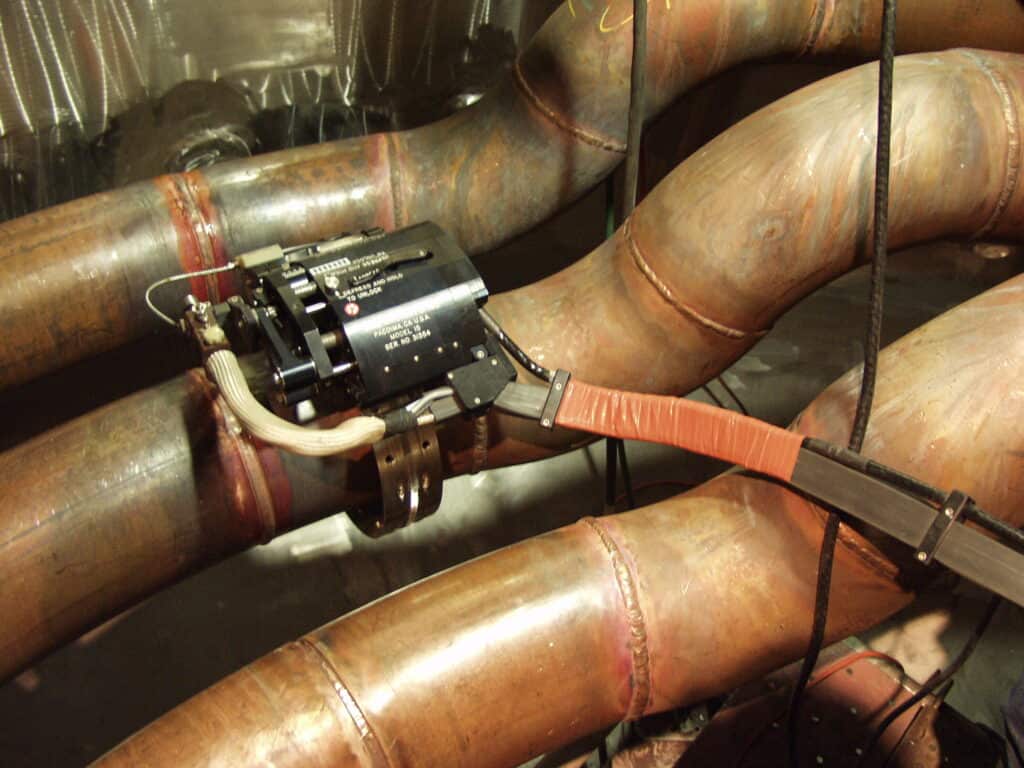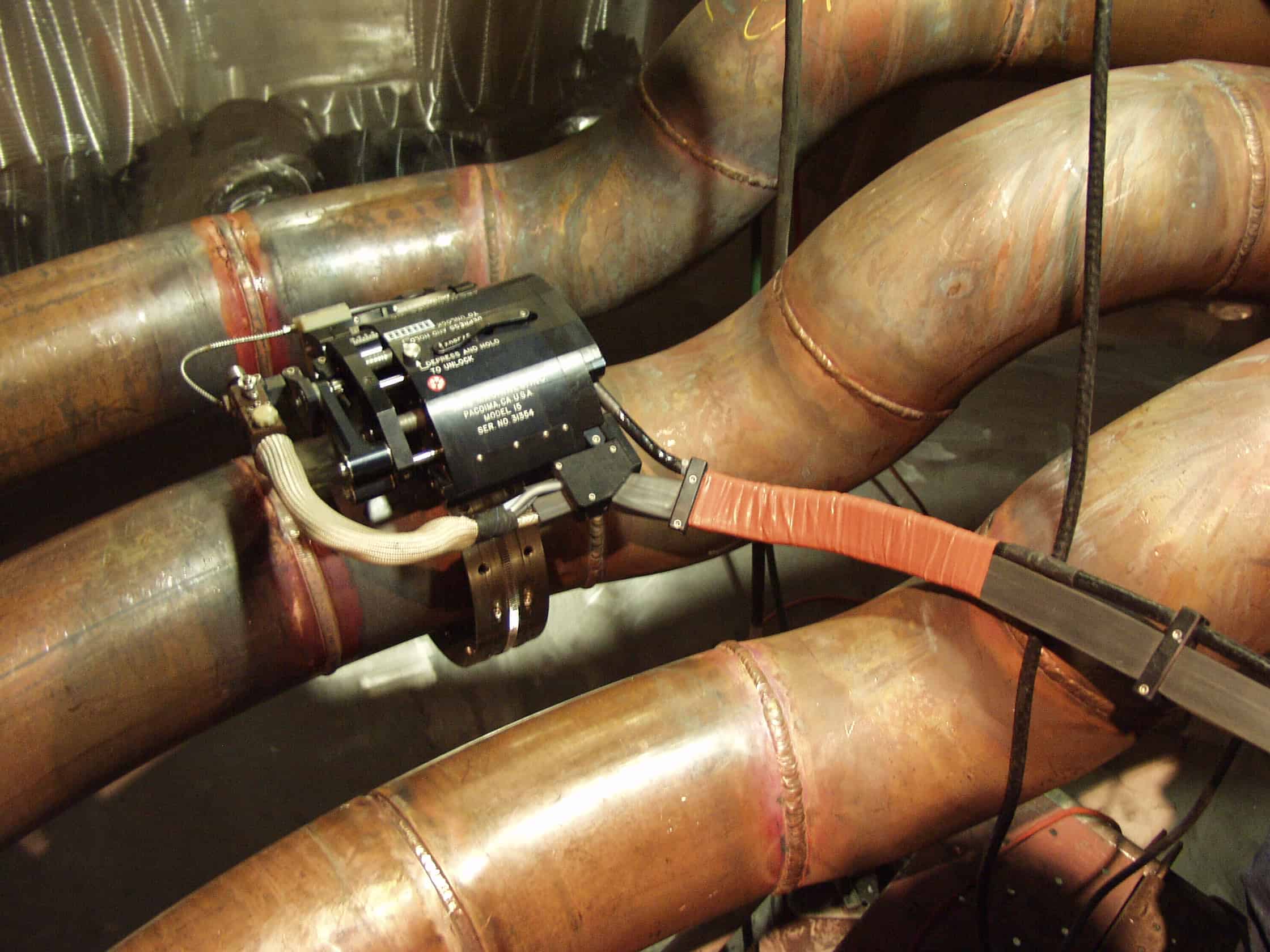
Equipment issues that arise in the middle of welding are infuriating. Welders in every type of welding process know the blank moment of surprise that comes along with a stuck rod, a wire that curls off instead of striking, or a tungsten electrode ruined by inexplicably crashing into the weld. They are all too familiar with the overwhelming frustration that immediately follows this surprise, too.
The same frustration is known to orbital welding machine operators. It may be even stronger, as orbital welding requires significant preparation and setup time. Keeping orbital arc welding machinery in good working order helps prevent this type of frustration, as well as costly rework and equipment replacement. A daily five-minute orbital arc welding machine inspection can spot problems before welding starts and can prevent many orbital welding hazards as well. Weld head maintenance, in particular, is one of the easier parts of keeping an orbital welding system in good repair. The weld head is open to visual inspections, and maintenance issues are often easy to spot. Correctly diagnosing and remediating weld head issues before they become major problems can go a long way toward saving money and time on a welding project.
The Importance of Manufacturer Parts and Training
Orbital weld heads are complex machines that depend on precisely controlling the movements of a tungsten electrode, the electrode’s distance from the weld joint, the timing of how the wire feed—if present—is fed into the arc, and how all these elements relate to each other. As a result, orbital weld head maintenance and repair can get complicated. Replacing a manufacturer’s original part with one from a third party can alter how these elements interact with each other. Dimensions that are slightly different can change the timing between elements. Materials that aren’t to manufacturer specifications may have lower heat or wear tolerances and fail unexpectedly during welding.
By following an inspection schedule, the operator can also spot wear and schedule service before a small problem has the opportunity to disrupt daily operations.
For all of these reasons, it’s best to use only parts provided by the manufacturer to perform any orbital weld head repair. It is also wise to have more complex weld head maintenance and repair performed by a service technician certified by the manufacturer. However, weld head issues, like an improperly seated wire feed spool or gas line connection to the weld head, can be fixed by the operator. By following an inspection schedule, the operator can also spot wear and schedule service before a small problem has the opportunity to disrupt daily operations.
Conducting Routine Orbital Weld Head Maintenance
The most basic orbital weld head maintenance simply involves taking the time needed to perform daily maintenance tasks, such as draining the weld head of coolant if it will be sitting for a while. This helps prevent algae from growing in the coolant lines and keeps the coolant seals from becoming damaged, avoiding more serious repairs. Taking a moment to look over the weld head as part of a daily orbital welding risk assessment can save hours of effort cleaning out and reworking welds and will help weld heads last longer without significant downtime or expensive repairs.
One of the most basic types of weld head maintenance is checking the weld head to ensure that the gas lenses and all gearing and mechanisms are free of foreign objects that can impede their movements.
During this visual inspection, operators should look for:
- Discoloration: It’s no secret that welding generates a lot of heat, and repeated exposure to heat can cause changes in the molecular structures of parts and equipment exposed to it. Bluing of metal components or darkening of gas lenses can indicate that these components are being worn due to heat. This can also indicate that coolant systems aren’t functioning correctly.
- Leaks: Any weld head maintenance inspection or diagnostic should check for leaks of coolant, lubricants, or gases. Leaks can cause contamination of the weld when coolant gets into the molten metal, lubricants like grease contaminate the workpiece, or gas pressures fall below the threshold needed to shield the weld from contamination.
- Fouling: Metalworking environments inevitably contain metal shavings from machining, spatter from welding, dust from various sources, and a whole host of other foreign materials. One of the most basic types of weld head maintenance is checking the weld head to ensure that the gas lenses and all gearing and mechanisms are free of foreign objects that can impede their movements. The operator should remove any fouling discovered that impedes the movements of an orbital weld head’s gearing or feeding mechanisms.
- Wear: Weld head gearing, wire feed tips, wire feed rollers, and the wire feed conduit should be routinely checked for signs of wear. Worn wire feed tips will cause the wire to wander, worn wire rollers will keep the wire from feeding smoothly, and worn gearing can disrupt the travel speed of the weld head or the oscillation of the electrode. Scratching or other signs of surface wear indicates that it is time to replace parts like wire feed tips, or to call for servicing of parts the operator cannot replace themselves.
Not every issue that requires weld head maintenance is plainly visible. Sometimes issues, such as the wearing of gears and bearings, are subtle enough that they can most easily be discerned by looking at the weld itself.
Weld Quality Factors That Indicate a Need for Maintenance
The way that a weld forms during the orbital welding process and the appearance of a weld after it is finished can both reveal possible weld head maintenance or repair issues.
Severe Contamination
The most common issue with weld quality in gas tungsten arc welding (GTAW), whether orbital or manual, is contamination of the weld, usually caused by inadequate prep work. Weld head issues that cause a high level of contamination such as porosity or scaling are usually readily apparent during a visual inspection of orbital welding equipment prior to beginning. A coolant or lubricant seal failing during welding could cause significant contamination of the weld, but the source of the problem should be very clear.
Minor Contamination
Smaller-scale contamination, in which the weld is formed more or less correctly but is discolored and has a gray or blue appearance, is more likely than major contamination to indicate a weld head maintenance issue. In this case, the contamination is likely either a gas flow problem from a leak or a restriction in the line, or fouling and wearing of the gas lens that keeps it from properly shielding the line. Charging the line to pressure and seeing if the pressure holds steady for 30 minutes will reveal whether there are gas leaks in the line. Visually inspecting the gas lens for fouling or wear, replacing it, and checking the gas connections in the weld head should diagnose the problem. If it persists and any external environmental problems are ruled out, then it is time for maintenance and servicing by a qualified technician.
Weld Formation Inconsistency
Issues in how the weld is forming can clearly indicate a weld head maintenance problem. Binding in the gears can cause inconsistent travel as the gears freeze and then release. This is indicated by a wider spot in the weld, narrowing where the gears released, and then resumption of normal welding.
When a problem occurs like the one described above, a fully trained operator with a high level of familiarity with orbital welding machinery could open up the weld head and replace the gears with new, manufacturer-provided ones. However, given the precision of an orbital welding system, part replacement is best performed by the manufacturer or a certified service provider who can not only replace the affected parts, but also perform testing to ensure that no other weld head maintenance or repair needs to be performed. They can also calibrate the whole system to ensure that all elements and components are working together correctly. For this reason, it’s important to choose an orbital weld head manufacturer that offers a high level of support, including customized maintenance programs, field service programs, and access to highly trained orbital welding service technicians.
Arc Machines, Inc. is a long-time industry leader in orbital welding equipment for pipe and tubing with decades supporting clients in high-specification industries. For inquiries regarding products, contact sales@arcmachines.com. For service inquiries, contact service@arcmachines.com. Arc Machines welcomes the opportunity to discuss your specific needs. Contact us to learn more.





